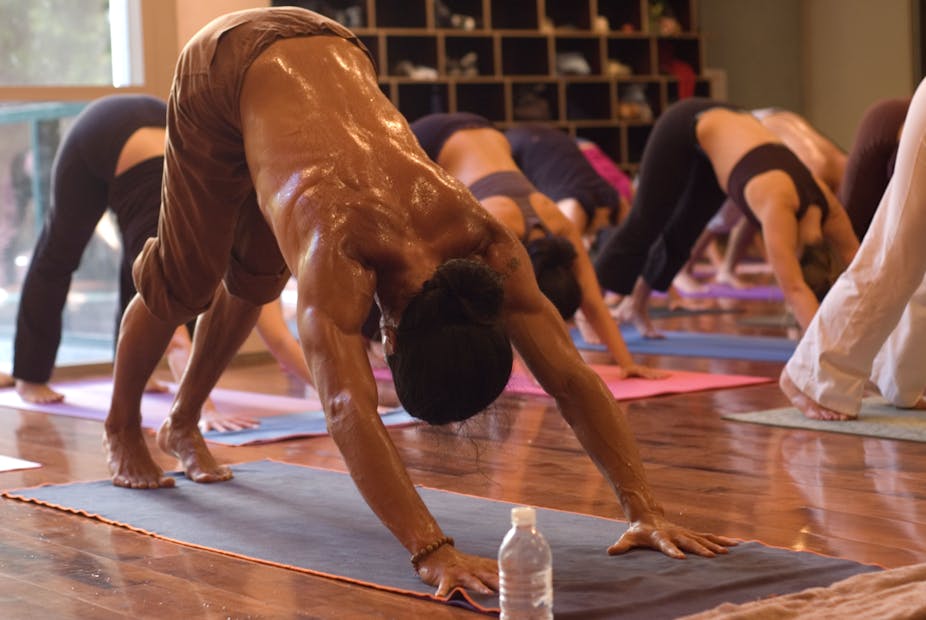Hot yoga also known as Bikram yoga (more on that later) has gained significant popularity in recent years as a fairly ferocious form of exercise. It combines yoga poses and breathing exercises and is practised in a heated studio – with room temperatures close to 40°C.
This style of yoga is designed to replicate the environmental conditions of India and is typically practised for around 90 minutes, leaving students (and teachers) dripping in sweat come the end of class.
Practising hot yoga challenges the mind and places additional physiological strain on the body. It makes you very sweaty and increases your heart rate, which can feel pretty intense. Indeed, hot yoga can lead to dehydration and dizziness, especially if it’s your first time and you don’t begin the class hydrated.
Designed to develop strength, flexibility and balance, hot yoga is believed to offer enhanced physical and mental health benefits – including improved levels of fitness and reduced stress levels.
But it can also feel uncomfortable – think sweat trickling into your eyes while doing a headstand – and hard going: with fast, dynamic sequences repeated numerous times. Then there are also those tricky balances and multiple lunges, all done at high temperatures, meaning that at times classes can feel pretty gruelling.
So are all these hot sweaty postures actually any good for you? Let’s take a look at the science.
The origins of hot yoga
Before we go into the evidence, a bit on the history. Originally known as “Bikram yoga”, named after its creator Bikram Choudhury, the traditional style of hot yoga was developed in the early 1970s. It involves a series of 26 fixed postures, carried out over 90 minutes while experiencing extreme heat stress.
In recent years many yoga studios have chosen to rebrand these classes as “hot yoga”, having changed from the original 26 fixed postures to be more flowing and individual and to include music (which Bikram classes don’t).
Another reason many yoga studios have chosen to move away from the Bikram style of yoga is that multiple women have come forward with accusations of sexual harassment and assault against Choudhury. This has led to legal action and been the focus of a 2019 Netflix documentary: Bikram: Yogi, Guru, Predator.
Even before the Bikram scandal, not everyone in the yoga community backed the idea of hot yoga. This is because traditional yoga practice involves a series of postures known as sun salutations, which are performed early in the morning (when it’s cooler), not during the midday heat.
What the science says
Although comprehensive scientific reviews are still lacking, some studies have indicated potential health benefits from hot yoga. Modified Bikram yoga performed regularly has been associated with increased aerobic fitness and improved cardiovascular function.
Hot yoga has shown promise in terms of heart health, by lowering “bad cholesterol” levels and improving glucose tolerance. Glucose intolerance may indicate an increased risk of metabolic conditions, such as diabetes.
It has also been linked to an increase in strength, flexibility and enhanced mental health, including improved stress management and sleep quality.

Yoga is classified as a “light-intensity exercise” by the American College of Sports Medicine but studies show that hot yoga sessions can result in high heart rates, increased core temperatures of 38˚C-40˚C and substantial sweat losses – up to 1.5 litres per session – making it a more intense exercise.
When it comes to hot yoga classes, research has also found that novices and experienced practitioners exhibit similarities in heart rate but can differ in sweat rate and core temperature changes. The more experienced you are, the more you sweat and the hotter you may get. This is likely because more experienced hot yogis will be better adapted to the heat and so able to push harder.
It’s often claimed that practising yoga in a heated environment may help with “detoxification” and the release of toxins from the body due to excessive sweating. But this is rubbish – that’s what our kidneys are for. The reality is that those who practice hot yoga will probably lose more sodium (or salt) and so are more likely to become dehydrated through increased sweat loss compared to yoga in cooler conditions.
Given this, hot yoga may be of benefit to those wishing to adapt to heat stress. For example, athletes preparing for elite sports such as hockey – if performed safely.
And the risks?
Because hot yoga can be physically demanding, it may not be suitable for everyone, especially for those with certain medical conditions or sensitivity to heat. Plus, some of the research looking at the benefits of hot yoga hasn’t been replicated – essentially meaning that further investigations are required to fully understand the true value of hot yoga in terms of physical fitness.
So while it does seem that there are some potential benefits, it’s important to be mindful of the potential risks associated with hot yoga, too. The heated environment, for example, can increase the risk of dehydration, heat exhaustion and potentially heat stroke, especially if proper hydration practices are not followed.
People with certain medical conditions, such as heart disease or high blood pressure, or those who are pregnant may need to exercise caution or consult their doctor before participating in hot yoga. And it’s vital that students listen to their bodies, take breaks when needed and stay hydrated throughout their practice.
With hot and humid conditions, on top of excessive sweating, hygiene and cleanliness is also important for you and your mat. So don’t forget your towel and wipe your mat down afterwards too.

